Preparing System Analysis Activities for University Library
Question
Task:
In this assignment, you are required to prepare various system analysis activities for the proposed university library system.
This assignment has four (4) tasks as described below:
Task 1. Identify and briefly describe the functional and non-functional requirements for the proposed system. (3 pages, times new roman, size 12).
Task 2. Draw a use case diagram using all possible use cases and actors for University Library System. Also write brief use case descriptions for any five (5) use cases.
Task 3. Develop System Sequence Diagrams (SSD) for the use cases you have identified in Task 2 of this assignment, so you need to develop five (5) SSDs.
Task 4. Write a fully developed use case description using ONLY one use case for the proposed University Library System.
Answer
Functional and Non-Functional Requirements
Functional Requirements for System Analysis
The functional requirements and specifications to be included on the system are listed in the points below.
- To enable the users to securely login to the university library system by providing their unique ID and one-time password received on the registered mobile number
- Search functionality with specific categories, such as journals, articles, e-books, etc. enabling users to perform the search based on the keywords provided
- To allow the users to share the information using the system with the other users and resources (Becker et al. 2017)
- Users shall be able to view the entire catalogue offered by the library with features categories on the home screen of the system
- Acquisition manager shall be able to order new books and article to be included in the library
- Students should be able to borrow the specific items from the library by specifying the return date and time
- The availability status of every item shall be updated as soon as a student borrows a particular item (Al?Hawari et al. 2017)
- Recommended products shall be displayed by the system to the learners and the student based on the items they borrowed in the past and the search history
- Inter-library and photocopy features shall also be included
- System shall provide sharing of audio and video files and material present in the library
- Users shall be able to update and manage their demographic details and information through the system
- Users shall be able to end the session upon usage and must be able to log out from the system.
- User should be able to check the associated fine in real-time i.e. with every passing overdue date, fine shall be calculated and same should be notified to the user.
- If a book is not available for issue at a point of time, then the user can request for reserving it. When the book becomes available for issue, then the system should notify about it to the user.
Non-Functional Requirements
Following are the non-functional requirements that must be present on the system.
- Availability: Learners, students, and other users on the system may wish to access the system at their preferred time and the system must always be available to the end-users at any times.
- Security: System shall include in-built security tools and controls so that the security of the information sets and privacy is always maintained. For example, the access control and authentication features include the use of one-time passwords to log in. This will make sure that only authentic users get to access the system information and features. Similarly, security shall be maintained as an essential quality in all the other areas (Alzahrani et al. 2019).
- Scalability: System shall allocate and de-allocate the resources as per the requirement. Optimal resource allocation and ability to make changes shall be present in the system. This shall include scaling up or scaling down the system as per the need.
- Usability: System must be easy to use with inclusion of the functional requirements as per the user specifications. The system shall be easy to use and navigate and it shall include error resolution and smooth scrolling capabilities.
- Maintainability: System must be easy to maintain. There can be certain updates that may be required to be made on the system from time to time. These updates shall be installed with ease.
- Performance: The performance of the university library system shall be unmatched. The system shall include quick response and throughput time for all the actions of the users performed on the system (Cristobal 2018).
- Capacity: The proposed system should be able to perform 100 transactions in 1 minute. At any point of time, the system should be able to store 1TB data.
- Recovery: During database crash, the system should be able to recover with in 2-3 hours and backup should be taken on weekly basis.
- Usability: The proposed should have low learning curve and it should be designed according to the specially-abled end users as well.
- Compatibility: It should be platform independent and it should be able to other sub-systems of the university. It should also be able to integrate with 3rd party applications and should run on OS such as MacOS.
- Integrity: The proposed solution should be able to maintain data integrity and consistency. It should follow industry standards for image compression and decompressions.
Use cases
Following are key use cases of the proposed system:
- Login/Logout – The user should be able to login and logout from the system.
- Register – User is able to register oneself on the system using the valid login credentials.
- Search book – User should be able to search a book.
- Issue book – Librarian should be able to issue an available book.
- Calculate fine - Librarian should be able calculate fine and it should be notified to the respective user accordingly.
- Remove user – Librarian should be able to delete the user from the system.
- Borrow Book – User should be able to borrow a book.
Use case diagram
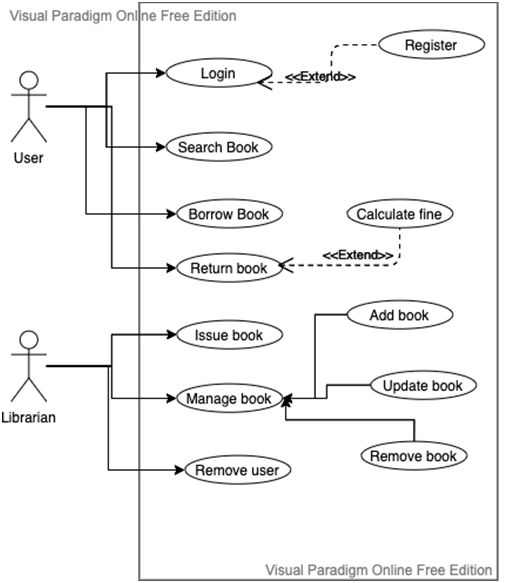
System sequence diagram
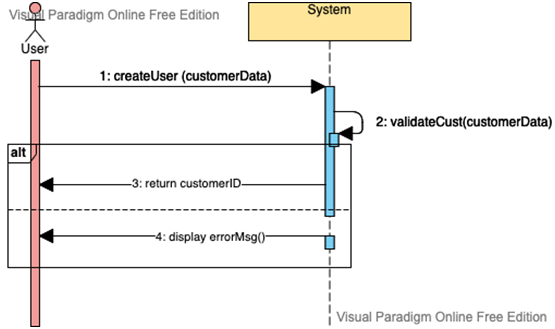
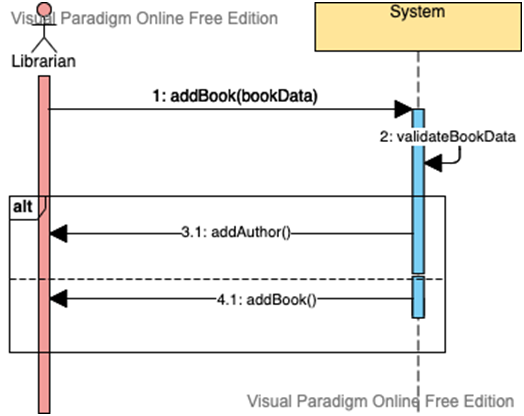
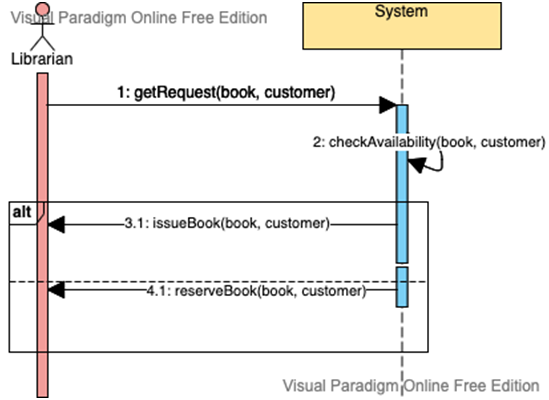
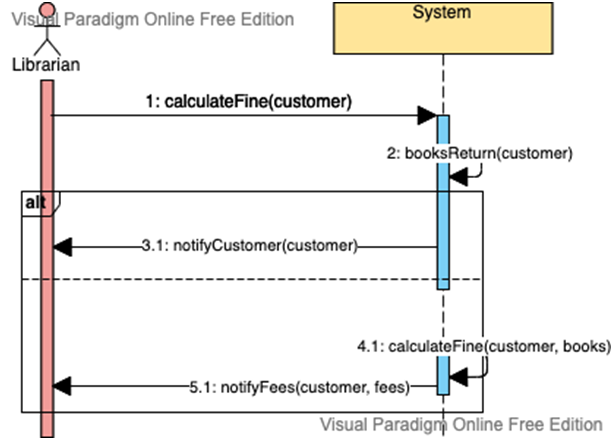
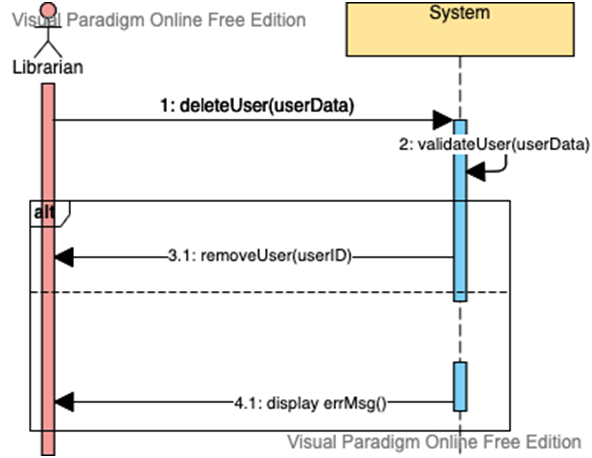
Use case description
|
Use Case Name |
Registration |
|
|
ID |
U001 |
|
|
Priority |
A new user needs to borrow book. |
|
|
Actor |
User, System |
|
|
Description |
User wants to create an account in the system to borrow book. |
|
|
Trigger |
Non-member wants to register. |
|
|
Precondition |
User can access the system to create a new account. |
|
|
Normal Course |
User |
System |
|
|
1. User clicks on “Create account”. 2. User enters all the details (A1). 3. User submits the form. |
4. System creates a new User(A2). 5. System displays login details.
|
|
Alternate course |
A1: If mandatory fields are not enters, system displays error message. A2: If user with given details are already present then system raises and error message.
|
|
|
Post conditions |
User is able to register successfully. |
|
References
Al?Hawari, F., Alufeishat, A., Alshawabkeh, M., Barham, H., &Habahbeh, M. (2017). The software engineering of a three?tier web?based student information system (MyGJU). Computer
Applications in Engineering Education, 25(2), 242-263.
Alzahrani, A. I., Mahmud, I., Ramayah, T., Alfarraj, O., &Alalwan, N. (2019). Modelling digital library success using the DeLone and McLean information system success model. Journal of Librarianship and Information Science, 51(2), 291-306.
Becker, D., Hartle, H., &Mhlauli, G. (2017). Assessment of use and quality of library services, accessibility and facilities by students at Cape Peninsula University of Technology. South African Journal of Libraries and Information Science, 83(1).
Cristobal, A. S. (2018). Expectations on library services, library quality (LibQual) dimension and library customer satisfaction: relationship to customer loyalty. Library Philosophy and Practice (e-journal), 1706, 1-24.












